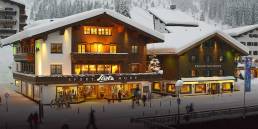Come for the peaks, stay for the innovative architecture. Switzerland’s continuing appeal delivers more than just four walls.
There are many Swiss clichés, and most of them are true. Trains and buses run on time. There are a lot of bankers. They like cheese. And they love to keep things tidy and organized. Exhibit A: the Swiss farmer’s wood pile. Scour the globe, you’ll never find another stacked with the clinical precision you’d see in any Swiss mountain village. This sort of cleanliness must be an inherited trait. The Swiss have a pride in workmanship and quality that is noticeable the moment you set foot in the country. And it’s more than Tissot watches and Piaget jewelry. It’s about architecture — and creating the world’s most beautiful mountain structures out of wood, rock and metal.
For two weeks in March, I bussed and trained around Switzerland with my ski gear in a bag and a mission to explore the heritage of architecture and design that give Switzerland’s mountain towns such a unique flare – some well-known, others obscure.
Much More Than a Lift Shack
The top station of a ski lift is a means to an end, the place where you ski off excitedly towards your destination — your favorite run, that secret powder stash that only you (and hundreds of others) keep in the back pocket of your ski pants for storm days. Utilitarian design at its best. If you’re lucky, a lift attendant will be sitting in his shack, smoking a Marlboro, and listlessly watching skiers off-load like lemmings, one after another. But can the lift station be reimagined into something that is a destination in and of itself? Trust the Swiss to believe it possible.
At Chäserrugg, a modest ski resort with an interesting story in the canton of St. Gallen, they went straight to the top and knocked on the door of Swiss starchitects Jacques Herzog and Pierre de Meuron.
Opened in 2015, the final price tag of $50 million was high but worth it, says Eppenberger. For the sake of style, they even decided to sacrifice considerable ad revenue potential.
“It was important for us that we did something that honors the location. It had to be high quality. All the wood came from the valley and we worked with local contractors,” she says.
Today, many visitors make the trip to Chässerrugg just to have lunch at this Herzog & de Meuron creation – an architectural tribute to the mountains and to skiing.
Mist as a dense as muesli swirls around the mountaintops as I turn tentatively down a groomed run, skiing by Braille and straining for fluorescent orange wands to guide me. On this late spring day, I have the slopes of Chäserrugg all to myself. Poor visibility equals a long lunch so I arrive early to meet Melanie Eppenberger, chairwoman of Toggenburger Bergbahnen at the resort’s signature summit lift station.
“It was a coincidence. I met Pierre [de Meuron] at a party in Zurich,” Eppenberger tells me as we sit down for lunch and I eye up a venison stew.
With asymmetric roof lines, floor-to-ceiling windows, and lofty fir post-and-beam construction, the building is both futuristic and a nod to traditional Swiss craftmanship. It is also a very special place for concerts, meetings and weddings. The light-colored wood and expansive windows fill the space with warmth. But there’s something else about the structure that takes a moment to pinpoint: there’s not a single plug for Audi or any other brand sponsor, nothing to distract or detract from the striking design.
“They built it near Geneva, packaged it up and trained it to Visp. From there they loaded packages onto horses for the trip up here,” says Dario Andenmatten, a second-generation hut custodian who grew up scrambling and skiing in the surrounding mountains and helping his mom and late father greet guests, serve coffees and schnapps, and scrub the dishes.
In 1926, workers built stone walls around the original wooden structure. With stalwart 25-inch-thick stone walls that keep warmth in and the cold out, subsequent renovations have stayed true to the original design.
Not so at the Monte Rosa Hut, perched above the Gorner Glacier near Zermatt. I click into my skis after off-loading the Gornergrat rack railway, then slide away from the crowds to a bend in the meandering blue run that descends from the ridge. From there I scan the fractured surface of the Gorner Glacier far below, following it to where the ice gets steep and the roof of this iconic mountain monument sparkles like a diamond in the sun. Fifteen years ago, glacier recession was dangerously destabilizing the foundations of the original hut, built in the late 1800s. The Swiss Alpine Club needed to renovate or move it. Word reached Andrea Deplazes, an architect and instructor at the Swiss Federal Institute of Technology in Zurich, about a design opportunity. So began a unique collaboration between the University and the Alpine Club.
“We wanted to see what was possible in terms of designing an autonomous, self-sufficient building in a location with no road access,” explains Deplazes from his office in downtown Brig. “But it was a balancing act. The Alpine Club was very conservative and the University was progressive.”
Deplazes took it on as a master class. It started with a design competition among students and the sky was wide open. No idea, no matter how outlandish or radical, was off the table. Over the course of two years and four semesters, proposals were whittled down to a design that balanced engineering feasibility with cutting-edge sustainability. The result is stunning. A shining aluminum shell wraps around a CNC (computerized numerical control) wood frame that eschews conventional 90-degree corners. The steep roof mimics the acute angles of the Matterhorn, which dominates the skyline and seems to mock its peers. Inside, a staircase spirals around the perimeter, providing panoramic views of the mountains and acting as a natural trap for circulating passive solar energy throughout the hut. Solar panels supply the hut’s electricity needs and super-efficient composting toilets produce a single barrel of garden-ready compost every year. More than a dozen years since opening, the modern Monte Rosa hut is still considered a model of sustainable building design in Switzerland.
“The students were very engaged,” says Deplazes, who still gets excited thinking about the Monte Rosa project. “We were more or less all just city people exploring what was possible to design in a mountain environment.”
Vals, a Museum of Modern Architecture
Fat snowflakes drift lazily from the sky as I follow a hiking trail that switchbacks through old forests. Far below the vision and aesthetic of Peter Zumthor have left an indelible mark on the Graubünden Valley and the village of Vals. The Basel-based architect is perhaps best known for his minimalist, almost austere approach to design, exemplified by the ethereal thermal baths at 7132 Thermes, a tiny hotel on the outskirts of Vals. Built from more than 60,000 pieces of locally quarried greenish-grey quartz stone, the mineral pools create a sensory experience that transports one to a different time, perhaps a Roman bathhouse at the height of the empire. Massive square columns and high ceilings create acoustics almost as impressive as the soothing waters themselves.
True architecture buffs have even more reason to travel to Vals – to spend a night in the unusual House of Architects. Consider it modern architecture’s version of fashion over function. The “house” is contained in a separate building connected to 7132 Thermes by a suspended glassed-in walkway.
The concept was simple. Zumthor, with Japanese architects Tadao Ando and Kengo Kuma, and American Thom Mayne, was given free reign to design hotel rooms, each one an identical, ultra-minimalist, 216 square feet in size. The results are quirky, kitschy and even bizarre, but always fun. I stayed in 8090, which was designed by Mayne’s California-based Morphosis Architects. The room is entirely clad in wood — walls and ceilings — with a queen bed at one end and a curved glass shower stall at the other, obscured for privacy with the flick of a switch. Detailed lighting gives the room the feeling of a space capsule. Mayne designed a companion to the Wood Room, called the Stone Room. It’s identical except – you guessed it – the room is clad in stone instead of wood.
Built to Last
On a sunny spring morning, I ski tour deep into the Binntal Nature Park towards its namesake Binntalhütte, a stout stone hut straddling the Swiss-Italian border. It’s a route that smugglers once traveled, locals are fond of saying. But I came to the Binntal region for another reason – to visit the tiny village of Mühlebach. It’s a sleepy place, even in summer during peak hiking season. In winter, you could hear a horseshoe drop from a mile away. Less than 100 people live here but its stout wooden houses are some of the longest lived in Switzerland. For example, Schinerhaus dates to 1478, an astounding testament to wood as building material. Though the houses have been completely modernized inside, on the outside they appear just as they first did when the medieval craftsmen of Mühlebach burned the surface of the timbers to preserve them before framing. It gave them a dark, sunburned appearance that remains to this day. Mühlebach’s tiny town’s centre is considered one of the oldest squares in Switzerland surrounded by wooden buildings.
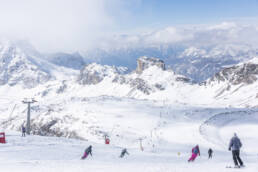
When In Switzerland
In Grindelwald the new and old mix easily. A welcome delivery of late spring powder has blanketed the low-elevation pastures that, only the day before, were an electric green. I soar up the ultra-modern Eiger Express Gondola in time for a few powder laps on Kleine Scheidegg. An hour later I meet Sandra Kaiser, a guide for Jungfrau Railway, then board the cog train for the 20-minute journey to Europe’s highest train station, Jungfraujoch, at 3,454 metres. The railway that tunnels through the Mönch and Eiger, the most storied mountain in Alpen climbing history, was the vision of Swiss industrialist Adolf Guyer-Zeller. Construction began in 1896 and was completed 16 years later, long after Guyer-Zeller passed away. Six men died in its construction.
“We’re like a piece of Swiss cheese. We have more than 2,000 kilometres of tunnels in the country,” Kaiser says, obviously proud of her people’s tunneling temerity.
The Swiss don’t normally do tacky, but at Jungfraujoch all bets are off. There’s Lindt Swiss Chocolate Heaven, surround-sound theatre, and a subterranean ice sculpture palace. But still, somehow, it’s worth the side-trip, if only to ride a train through a legendary mountain to a sky-high view of the Aletsch Glacier and gawk at the Sphinx Observatory. Opened in 1937, this world-leading observatory and atmospheric research centre clings to the rock like something cut and pasted from the brain of sci-fi novelist. So visibly arresting is this two-domed mountain edifice that American auteur Wes Anderson featured it in his 2014 film The Grand Budapest Hotel.
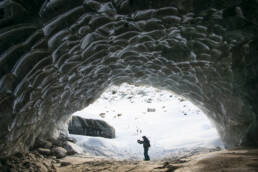
But you won’t find Beat “Yeti” Huttmacher in the Lindt chocolate museum anytime soon. After a morning skiing at Wengen and paying patriotic tribute to the legendary “Canadian Corner” on the Lauberhorn World Cup downhill course, I meet Huttmacher in Grindelwald. A retired mountain guide, he has a much different vision of the iconic Swiss Alps experience than the Jungfrau Railway. Ever since he was a young man, he dreamed of buying and renovating an old Swiss farmhouse in the mountains. Now he owns six, including Kirschbaumhütte, a rustic one-room wooden hut with a sleeping loft situated in a meadow of its own at the end of a bumpy mountain road. No electricity, no hot water, no wi-fi. Just a wood-fired stove, a thick woolen duvet on the bed, a rustic table and a five-star valley view.
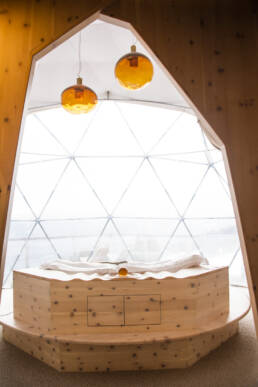
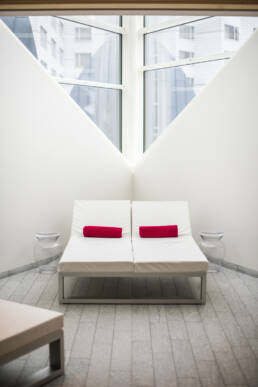
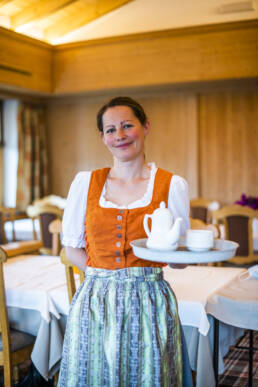
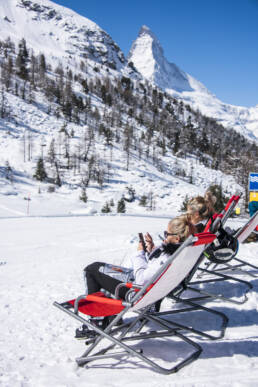
“I love giving new life to old buildings. I could put in solar panels for electricity but it would be too much like regular life,” he says. “It’s kind of like going back to the 19th century, Heidi-style.”
And that’s what I do on my last night in Switzerland, stepping back in time to unplug and experience a snapshot of what life was like in the Swiss Alps a few centuries ago.
After 10 days of exploring huts, hotels, and curious architectural monuments, I learned something that I sort of already knew: Switzerland celebrates quality, whether a five-star hotel or 500-year-old farmhouse – a characteristic burned into the DNA of a people who over many centuries have mastered the art of building and living in the mountains.
Article by ANDREW FINDLAY
Photography by KARI MEDIG
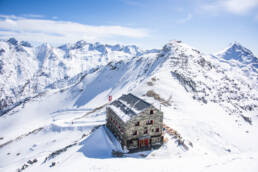
Related Posts
December 11, 2019
Fast Forward-Lindsey Vonn Article & Photoshoot
What Lindsey Vonn has been up to since…



